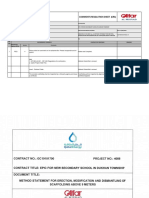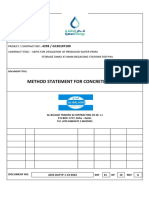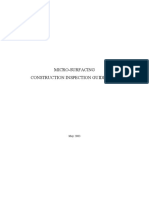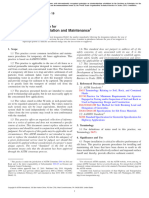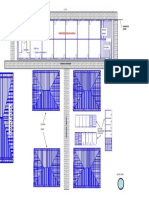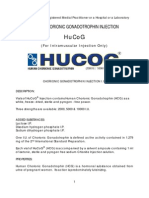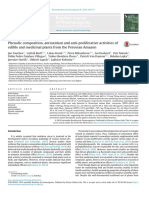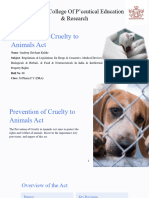1508
1508
Uploaded by
zulCopyright:
Available Formats
1508
1508
Uploaded by
zulOriginal Description:
Copyright
Available Formats
Share this document
Did you find this document useful?
Is this content inappropriate?
Copyright:
Available Formats
1508
1508
Uploaded by
zulCopyright:
Available Formats
NZQA registered unit standard 1508 version 7
Page 1 of 8
Title Plan and organise construction activities as an asphalt paving
supervisor
Level 4 Credits 15
Purpose This unit standard is designed for people working, in the
pavement surfacing industry, towards recognition of
competency in the role of an asphalt paving supervisor.
People credited with this unit standard are able to: identify
constraints affecting the asphalt paving construction process;
confirm asphalt paving work requirements as an asphalt paving
supervisor; plan asphalt paving construction operations as an
asphalt paving supervisor; programme resources for asphalt
paving as an asphalt paving supervisor; confirm personnel,
plant, equipment, and materials as an asphalt paving
supervisor; plan and organise the control of health and safety
hazards and adverse effects on the environment as an asphalt
paving supervisor; and organise job activities, as an asphalt
paving supervisor, prior to commencing asphalt paving
operations.
Classification Pavement Surfacing > Asphalt Surfacing
Available grade Achieved
Entry information
Recommended skills Unit 1510, Demonstrate knowledge of asphalt mix options,
and knowledge pavement pretreatments, and asphalt paving operations
requirements; Unit 13521, Demonstrate knowledge of the
compaction of hot mix asphalt; and Unit 20447, Demonstrate
knowledge of the care and operation of an asphalt paving
machine, or demonstrate equivalent knowledge and skills.
Explanatory notes
1 The following legislation and requirements apply to this unit standard, and must be
complied with:
Health and Safety in Employment Act 1992;
Resource Management Act 1991;
Land Transport Act 1998;
Health and Safety in Employment Regulations 1995;
Traffic Regulations 1976;
Infrastructure ITO Ó New Zealand Qualifications Authority 2018
SSB Code 101813
NZQA registered unit standard 1508 version 7
Page 2 of 8
The Safe Handling of Bituminous Materials Used in Roading – Code of Practice RNZ
9904:2006, Roading New Zealand, available for purchase at
http://www.roadingnz.org.nz/;
The Bitumen Safety Handbook, Roading New Zealand, available for purchase at
http://www.roadingnz.org.nz/;
Chipsealing in New Zealand, New Zealand Transport Agency, available at
http://www.nzta.govt.nz/resources/chipsealing-new-zealand-manual/;
Code of Practice for Temporary Traffic Management (CoPTTM), New Zealand
Transport Agency, available at http://www.nzta.govt.nz/resources/;
New Zealand Transport Agency specifications at http://www.nzta.govt.nz/resources/:
NZTA P9: Specification for Construction of Asphaltic Concrete Paving;
NZTA P11: Specification for Open Graded Porous Asphalt;
NZTA P11 Notes: Notes to the Specification for Open Graded Porous Asphalt;
NZTA P9P (Auckland): Specification for Construction of Asphaltic Concrete Paving;
NZTA P23: Performance Based Specification for Hotmix Asphalt Wearing Course
Surfacing;
NZTA Q2: Specification for Quality Assurance for Hot Mix Asphalt;
Where specified in the contract documents, the following pilot specifications, or
confirmation of their currency, are available by contacting the Operations Manager,
New Zealand Transport Agency National Office, Telephone 04 894 6316;
NZTA P18P: Pilot Performance Based Specification for Hot Mix Asphalt;
Company quality plan;
Contract specifications;
Site safety plan;
Traffic management plan.
Any legislation or other requirements superseding any of the above will apply,
pending the review of this unit standard.
2 Assessment against this unit standard must be based on evidence from a workplace
context.
3 Evidence is required of at least ten job sites. Job sites may include but are not
limited to a wearing course, an open graded porous asphalt, a stone mastic asphalt,
and a structural pavement layer.
4 It is recommended that assessment against this unit standard precedes assessment
against Unit 1512, Supervise asphalt paving construction activities.
Infrastructure ITO Ó New Zealand Qualifications Authority 2018
SSB Code 101813
NZQA registered unit standard 1508 version 7
Page 3 of 8
5 Definitions
Asphalt paving supervisor refers to a person who works in the asphalt paving
industry with site responsibility for large, complex jobs, and/or oversight of several
smaller jobs at a number of locations simultaneously. The asphalt paving supervisor
has practical knowledge of contract law and contractual issues; detailed
understanding of asphalt paving construction, contract documents and specifications;
and, in an asphalt paving context, has defined responsibilities for planning and
organising construction work, managing site safety, issuing instructions to
forepersons and suppliers, team performance and productivity, contract
documentation, and quality assurance, with authority to manage operations and
make decisions relating to asphalt paving construction.
Company procedures refers to all documented policies, procedures, and
methodologies of the candidate’s employer at the time of training including but not
limited to those relating to health, safety, environment, quality, and operations.
Subcontractor refers to an individual or company employed by a general or prime
contractor to perform a specific task as part of a project. This may include a different
department within the contracted company.
Outcomes and evidence requirements
Outcome 1
Identify constraints affecting the asphalt paving construction process.
Evidence requirements
1.1 Constraints that may impact on the selection of equipment and the construction
process are identified.
Range examples of constraints are – climate, pavement shape, geometric
constraints, materials and equipment available, clearances, live
load limitations, vibration.
1.2 Contract specifications that are incompatible with site constraints or other
considerations are identified in accordance with company procedures.
Range other considerations may include but are not limited to –
availability of resources, mix type and thickness, traffic, restricted
working hours.
1.3 Factors affecting the selection of hot mix asphalt materials are identified in
terms of constraints on the use of compaction equipment.
Range constraints include but are not limited to – layer thickness, live
loads, vibration, geometrics, pavement strength.
Outcome 2
Confirm asphalt paving work requirements as an asphalt paving supervisor.
Evidence requirements
Infrastructure ITO Ó New Zealand Qualifications Authority 2018
SSB Code 101813
NZQA registered unit standard 1508 version 7
Page 4 of 8
2.1 Contract specifications are interpreted in terms of supervisor’s duties.
Range specifications – method based, performance based;
duties relating to – conditions of contract, technical section,
performance criteria, schedule of quantities, measurements,
maintenance requirements.
2.2 Specific requirements for contracts are confirmed in accordance with contract
specifications.
2.3 Surface pretreatments are confirmed as having been carried out in accordance
with appropriate quality assurance requirements and meeting contract
specifications.
2.4 Where further surface pretreatments are required, these are identified and
arrangements are made to have them carried out in accordance with company
procedures.
2.5 Asphalt paving construction requirements are confirmed in accordance with
contract specifications and company procedures.
Range requirements include but are not limited to – tack coats, depth of
mix, location, quantities.
2.6 Location and limits of paving are confirmed in accordance with contract
specifications.
2.7 Paving plant and materials are confirmed in terms of certification, availability,
and compliance with contract specifications.
Outcome 3
Plan asphalt paving construction operations as an asphalt paving supervisor.
Evidence requirements
3.1 Contract specifications that are incompatible with site constraints or other
considerations are resolved and/or provided for in accordance with company
procedures.
Range examples of considerations are – availability of resources, traffic,
restricted working hours.
3.2 Asphalt paving construction needs are identified in accordance with contract
specifications.
Range includes but is not limited to – surface preparation and preseal
repairs, adjustment of service covers, roadmarking, types of
material, worksite control, adverse effects on the environment,
public safety, access, measurement, work quantities, quality
assurance.
Infrastructure ITO Ó New Zealand Qualifications Authority 2018
SSB Code 101813
NZQA registered unit standard 1508 version 7
Page 5 of 8
3.3 Work programmes are planned and site activities are scheduled in accordance
with contract specifications and job requirements.
Range a one-day operation, a contract involving multiple site visits, a
contract involving subcontractors.
3.4 A paving plan detailing the sequence of operation and location of joints is
developed in accordance with contract specifications and job requirements.
Range may include but is not limited to – car park with complex shape
(horizontal and/or vertical), intersection with traffic islands,
roundabout.
3.5 The work programme and paving plan are reviewed in accordance with the
contract specifications.
3.6 The work programme for a contract of more than one day is submitted to the
project manager or consultant in accordance with contract specifications and
job requirements.
Outcome 4
Programme resources for asphalt paving as an asphalt paving supervisor.
Evidence requirements
4.1 Resource requirements are identified in accordance with contract specifications
and job requirements.
Range includes but is not limited to – plant, equipment, personnel,
materials, subcontracted work.
4.2 Work sequences and reporting procedures are planned and programmed in
accordance with contract specifications, job requirements, and company
procedures.
Range sequences include but are not limited to – hazard identification,
scope of work, breakdown of activity, prioritising;
reporting includes but is not limited to – costing data, work
programme, traffic management plan, quality assurance, work
progress, hazard, accident and/or incident.
4.3 The programme of work activities meets contract specifications and company
requirements in accordance with company procedures.
Range specifications – scope, timescale, completion, quality;
company requirements for – productivity.
Outcome 5
Confirm personnel, plant, equipment, and materials as an asphalt paving supervisor.
Infrastructure ITO Ó New Zealand Qualifications Authority 2018
SSB Code 101813
NZQA registered unit standard 1508 version 7
Page 6 of 8
Evidence requirements
5.1 Team numbers, positions, and duties are confirmed in accordance with
company procedures.
Range may include but is not limited to – identifying and arranging
training and on job supervision to meet contract specifications.
5.2 Plant and equipment requirements are confirmed in accordance with contract
specifications and company procedures.
5.3 Site accessibility and constraints are confirmed in terms of plant and equipment
requirements.
5.4 Materials are confirmed with suppliers in accordance with company procedures.
5.5 Programme requirements are confirmed with subcontractors in accordance with
company procedures.
Outcome 6
Plan and organise the control of health and safety hazards and adverse effects on the
environment as an asphalt paving supervisor.
Evidence requirements
6.1 Procedures and equipment for controlling health hazards are determined and
organised in accordance with Code of Practice RNZ 9904:2006 company
procedures, and legislation.
6.2 Procedures and equipment for controlling safety hazards are determined and
organised in accordance with Code of Practice RNZ 9904:2006, company
procedures, and legislation.
6.3 Procedures and equipment for controlling adverse effects on the environment
are determined and organised in accordance with Code of Practice RNZ
9904:2006, company procedures, and legislation.
6.4 Control and monitoring of health and safety hazards and adverse effects on the
environment are planned and documented in accordance with company
procedures and legislation.
Range at least two asphalt paving sites.
6.5 Selection of sites for specific operations are determined in terms of public safety
in accordance with company procedures and legislation.
Range operations – loading and unloading plant, cleaning equipment,
disposing of waste materials.
Outcome 7
Infrastructure ITO Ó New Zealand Qualifications Authority 2018
SSB Code 101813
NZQA registered unit standard 1508 version 7
Page 7 of 8
Organise job activities, as an asphalt paving supervisor, prior to commencing asphalt
paving operations.
Evidence requirements
7.1 Job activities are organised in accordance with work programme and contract
specifications.
7.2 Work space and haul routes are organised in accordance with company
procedures.
7.3 Traffic control is arranged in accordance with contract specifications and traffic
management plan.
7.4 Reporting procedures are organised in accordance with contract specifications
and company procedures.
Planned review date 31 December 2016
Status information and last date for assessment for superseded versions
Process Version Date Last Date for Assessment
Registration 1 21 October 1994 31 December 2013
Review 2 4 October 1995 31 December 2013
Review 3 24 March 1998 31 December 2013
Revision 4 5 January 1999 31 December 2013
Review 5 27 October 2005 31 December 2013
Revision 6 25 May 2007 31 December 2013
Review 7 15 March 2012 N/A
Consent and Moderation Requirements (CMR) reference 0101
This CMR can be accessed at http://www.nzqa.govt.nz/framework/search/index.do.
Please note
Providers must be granted consent to assess against standards (accredited) by NZQA,
before they can report credits from assessment against unit standards or deliver courses
of study leading to that assessment.
Industry Training Organisations must be granted consent to assess against standards by
NZQA before they can register credits from assessment against unit standards.
Providers and Industry Training Organisations, which have been granted consent and
which are assessing against unit standards must engage with the moderation system that
applies to those standards.
Infrastructure ITO Ó New Zealand Qualifications Authority 2018
SSB Code 101813
NZQA registered unit standard 1508 version 7
Page 8 of 8
Requirements for consent to assess and an outline of the moderation system that applies
to this standard are outlined in the Consent and Moderation Requirements (CMR). The
CMR also includes useful information about special requirements for organisations wishing
to develop education and training programmes, such as minimum qualifications for tutors
and assessors, and special resource requirements.
Comments on this unit standard
Please contact Infrastructure ITO askus@infratrain.co.nz if you wish to suggest changes to
the content of this unit standard.
Infrastructure ITO Ó New Zealand Qualifications Authority 2018
SSB Code 101813
You might also like
- Performance Based Aiport Asphalt Specification v1Document41 pagesPerformance Based Aiport Asphalt Specification v1shachen2014100% (1)
- Method Statement For GeotextileDocument17 pagesMethod Statement For GeotextileGökhan Gökçe0% (1)
- Method Statement For External Stone Cladding (Marble and Granite)Document7 pagesMethod Statement For External Stone Cladding (Marble and Granite)Muthukumar Jayaveerapandian100% (1)
- Construction Project Organizational ChartDocument1 pageConstruction Project Organizational Chartzul60% (5)
- 005-CIVIL-MS Disposal of Excavated Materials PDFDocument15 pages005-CIVIL-MS Disposal of Excavated Materials PDFKöksal PatanNo ratings yet
- METHOD STATEMENT FOR Grassl - Rev 0Document6 pagesMETHOD STATEMENT FOR Grassl - Rev 0Osama MZNo ratings yet
- CidaDocument59 pagesCidadamith100% (3)
- Asphalt-Rubber Binder: Standard Specification ForDocument5 pagesAsphalt-Rubber Binder: Standard Specification ForMonica GuevaraNo ratings yet
- Sabp Q 015Document24 pagesSabp Q 015AdnanNo ratings yet
- Civil Work BQDocument26 pagesCivil Work BQzul100% (3)
- S-Curve Modules: HTML PDF PPT HTML PDF PPT HTML PDFDocument1 pageS-Curve Modules: HTML PDF PPT HTML PDF PPT HTML PDFzulNo ratings yet
- MASTER_SPECIFICATION_-_PART_RD-BP-D2_-_DESIGN_AND_APPLICATION_OF_SPRAYED_BITUMINOUS_SURFACING.DOCXDocument21 pagesMASTER_SPECIFICATION_-_PART_RD-BP-D2_-_DESIGN_AND_APPLICATION_OF_SPRAYED_BITUMINOUS_SURFACING.DOCXBander Al–kouhlaniNo ratings yet
- Super Flat StanderdsDocument4 pagesSuper Flat StanderdsAhmed ElsheikhNo ratings yet
- Quality Management SystemDocument21 pagesQuality Management SystemAugusto M. ReyesNo ratings yet
- METHOD STATEMENT FOR Paving - Rev 0Document7 pagesMETHOD STATEMENT FOR Paving - Rev 0Osama MZ50% (2)
- Report Highways-England Task-581Document247 pagesReport Highways-England Task-581vara prasadNo ratings yet
- Concrete Coating Procedure Rev - 01Document33 pagesConcrete Coating Procedure Rev - 01QC ManagerNo ratings yet
- CMChapter 4 Section 401Document23 pagesCMChapter 4 Section 401Mary Joy OrdonezNo ratings yet
- Rigid PavementsDocument70 pagesRigid PavementsJanya AssociatesNo ratings yet
- MASTER_SPECIFICATION_-_PART_RD-BP-C6_-_SLURRY_MICRO_SURFACING_OF_PAVEMENTS.DOCXDocument8 pagesMASTER_SPECIFICATION_-_PART_RD-BP-C6_-_SLURRY_MICRO_SURFACING_OF_PAVEMENTS.DOCXBander Al–kouhlaniNo ratings yet
- Saa00196 01Document5 pagesSaa00196 01cracktobeNo ratings yet
- METHOD STATEMENT FOR Cast in Situ Concrete - Rev 0Document7 pagesMETHOD STATEMENT FOR Cast in Situ Concrete - Rev 0Osama MZ100% (1)
- Saes Q 004Document24 pagesSaes Q 004tariqueNo ratings yet
- Concreting WorkDocument14 pagesConcreting WorkSantosh KumarNo ratings yet
- Title Operate A Straddle Carrier Level 3 Credits 6Document4 pagesTitle Operate A Straddle Carrier Level 3 Credits 6Hamouda EL Sayed SafanNo ratings yet
- Ground Improvement Procedure Rev.0Document14 pagesGround Improvement Procedure Rev.0Muhammad AfrasiyabNo ratings yet
- Material Approval Request (MAR) : DetailsDocument12 pagesMaterial Approval Request (MAR) : DetailsAshir RIZNo ratings yet
- 502.00 Asphalt Pavement 502.10 Asphalt Pavement DescriptionDocument30 pages502.00 Asphalt Pavement 502.10 Asphalt Pavement DescriptionAdjei BaldanNo ratings yet
- CV-0013-001 - Method Statement For Excavation and Fill WorkDocument11 pagesCV-0013-001 - Method Statement For Excavation and Fill Work한상호No ratings yet
- SSPC QP 8Document9 pagesSSPC QP 8FCTNo ratings yet
- IP MS 09 GroutingDocument4 pagesIP MS 09 GroutingZubair Ahmed KhaskheliNo ratings yet
- QA PIling WorksDocument4 pagesQA PIling WorkskjaikumarbeNo ratings yet
- MIP6-CV-0013-001 - Method Statement For Excavation and Fill WorkDocument12 pagesMIP6-CV-0013-001 - Method Statement For Excavation and Fill Work한상호No ratings yet
- Aashto FogsealDocument1 pageAashto FogsealmanolocatrachoNo ratings yet
- Method Statement For Erection of Scaffolding PDFDocument20 pagesMethod Statement For Erection of Scaffolding PDFChris Enyinnaya100% (3)
- Guideline Work Acceptance - 230201 - 164935Document14 pagesGuideline Work Acceptance - 230201 - 164935SureshNo ratings yet
- Application Procedure For Polibrid 705E System On Concrete Rev01Document9 pagesApplication Procedure For Polibrid 705E System On Concrete Rev01kholif noviantiNo ratings yet
- Pip CVS02350-2017Document15 pagesPip CVS02350-2017d-fbuser-93320248100% (1)
- 02 Method of Statment - DX High Wall Split Unit - PSDocument12 pages02 Method of Statment - DX High Wall Split Unit - PSUnique PlanningNo ratings yet
- Asphalt PavementDocument6 pagesAsphalt PavementirvisionresumeNo ratings yet
- Floor Systems Substations: L:A T As T Saudi ElectricitycompanyDocument18 pagesFloor Systems Substations: L:A T As T Saudi ElectricitycompanymohamedNo ratings yet
- 01 Method of Statement - Excavation & BackfillingDocument14 pages01 Method of Statement - Excavation & Backfillingnaram.ibrahimNo ratings yet
- R11 T02B01 Mag MTS Ci 0015Document15 pagesR11 T02B01 Mag MTS Ci 0015Syed AliNo ratings yet
- Title Manage Safety and Environmental Care On Roadmarking Sites Level 3 Credits 4Document3 pagesTitle Manage Safety and Environmental Care On Roadmarking Sites Level 3 Credits 4Ahmed AliNo ratings yet
- Method Statement For Concrete WorksDocument12 pagesMethod Statement For Concrete WorksRajarajan RajaNo ratings yet
- Micro-Surfacing Construction Inspection GuidelinesDocument12 pagesMicro-Surfacing Construction Inspection Guidelinesvinay rodeNo ratings yet
- Geomembrane Liner Installation AtarfilDocument24 pagesGeomembrane Liner Installation Atarfildavid1173No ratings yet
- MS For Cement Stucco (Exterior Application)Document7 pagesMS For Cement Stucco (Exterior Application)Alvene TagocNo ratings yet
- Document VgfgsDocument75 pagesDocument VgfgsManjar NadeemNo ratings yet
- Silt Fence Installation and Maintenance: Standard Practice ForDocument4 pagesSilt Fence Installation and Maintenance: Standard Practice Forososhamza220No ratings yet
- Method of Statement For Hdpe Under Ground Piping Fabrication & InstallationDocument20 pagesMethod of Statement For Hdpe Under Ground Piping Fabrication & Installationqadeer55afridiNo ratings yet
- SUBRAMANI VEDIAPPAN - VelosiDocument11 pagesSUBRAMANI VEDIAPPAN - VelosiKshama RaiNo ratings yet
- tprpw12Document10 pagestprpw12eng.amrfathiNo ratings yet
- SR 17 01316 PDFDocument44 pagesSR 17 01316 PDFInstaCritic 1234No ratings yet
- METHOD STATEMENT - ASPHALTING PavingDocument8 pagesMETHOD STATEMENT - ASPHALTING Pavingrehanapple3863No ratings yet
- Method Statement For GroutingDocument10 pagesMethod Statement For Groutinggofortravel.sanjerNo ratings yet
- Installation of Mechanical Interlocking PaversDocument12 pagesInstallation of Mechanical Interlocking PaversBobby OtienoNo ratings yet
- Title Operate A Vacuum Loading Vehicle For Wastewater or Stormwater Maintenance Level 3 Credits 5 PurposeDocument3 pagesTitle Operate A Vacuum Loading Vehicle For Wastewater or Stormwater Maintenance Level 3 Credits 5 PurposeSteve RossNo ratings yet
- Proposed Specification For Construction of Airfield Concrete PavementDocument18 pagesProposed Specification For Construction of Airfield Concrete PavementTim LinNo ratings yet
- Soil Nail MethodDocument9 pagesSoil Nail MethodsayzdanielNo ratings yet
- Shady Eid Civil Engineer CVDocument2 pagesShady Eid Civil Engineer CVshadi.sy.eid100% (1)
- Technical Aspects Related to the Design and Construction of Engineered Containment Barriers for Environmental RemediationFrom EverandTechnical Aspects Related to the Design and Construction of Engineered Containment Barriers for Environmental RemediationNo ratings yet
- Assignment EdoshDocument1 pageAssignment EdoshzulNo ratings yet
- Standards - Masters and Doctoral Degree - BI - (FB)Document82 pagesStandards - Masters and Doctoral Degree - BI - (FB)zulNo ratings yet
- Project Management For The HealthDocument2 pagesProject Management For The HealthzulNo ratings yet
- 010-05Oct09-COP Demolition Works-Corrected On 30th Sept 2009-1Document148 pages010-05Oct09-COP Demolition Works-Corrected On 30th Sept 2009-1zulNo ratings yet
- Mechanical Department Osh Organizational Structure: Ap. Ir. Mustafar Abd KadirDocument3 pagesMechanical Department Osh Organizational Structure: Ap. Ir. Mustafar Abd KadirzulNo ratings yet
- Safety Engineering: Devices and ProcessesDocument24 pagesSafety Engineering: Devices and ProcesseszulNo ratings yet
- SKRINE - Law Firm, Legal Service, Intellectual Property, Trade Mark, MalaysiaDocument3 pagesSKRINE - Law Firm, Legal Service, Intellectual Property, Trade Mark, MalaysiazulNo ratings yet
- Proposed New Building: Indoor GamesDocument1 pageProposed New Building: Indoor GameszulNo ratings yet
- BQ C6 Permata PDFDocument42 pagesBQ C6 Permata PDFzulNo ratings yet
- Application of Building PlanDocument2 pagesApplication of Building Planzul100% (1)
- BQ AmanDocument4 pagesBQ AmanzulNo ratings yet
- Dealing With Construction Permits in Malaysia - Doing Business - World Bank GroupDocument3 pagesDealing With Construction Permits in Malaysia - Doing Business - World Bank Groupzul100% (1)
- HSE-CDF-006 - Tool Box MeetingDocument1 pageHSE-CDF-006 - Tool Box MeetingzulNo ratings yet
- Highway Unit 1Document84 pagesHighway Unit 1zulNo ratings yet
- CEM417 - Group-Of-2 - Project No 2Document2 pagesCEM417 - Group-Of-2 - Project No 2zulNo ratings yet
- Highway Unit 1Document84 pagesHighway Unit 1zulNo ratings yet
- Highway Unit 1Document84 pagesHighway Unit 1zulNo ratings yet
- Subcutaneous Administration FluidsDocument10 pagesSubcutaneous Administration FluidsKhie SymbianizeNo ratings yet
- A Good VO2max Charts by Age, Gender, Sport and Athlete FitnessDocument1 pageA Good VO2max Charts by Age, Gender, Sport and Athlete FitnessShameer KsNo ratings yet
- Commitment To HSE Through Leadership: Land SurveyDocument14 pagesCommitment To HSE Through Leadership: Land Surveyrockznrollz0% (1)
- Site Selection For Life Sciences Companies in Asia by KPMGDocument62 pagesSite Selection For Life Sciences Companies in Asia by KPMGLong ChongNo ratings yet
- 24 NTPC Tanda-Ec13011-96Document11 pages24 NTPC Tanda-Ec13011-96blazegloryNo ratings yet
- HucogDocument3 pagesHucogSairam EdupugantiNo ratings yet
- MS 1Document20 pagesMS 1Bonieve Pitogo NoblezadaNo ratings yet
- Kesiapan Unit Rekam Medis Klinik Dalam MenghadapiDocument8 pagesKesiapan Unit Rekam Medis Klinik Dalam Menghadapikhusnul astriNo ratings yet
- BJL 3208 Lobbying and Advocacy CatDocument7 pagesBJL 3208 Lobbying and Advocacy CatestherNo ratings yet
- Shoulder Pain and Disability Index Spadi1 PDFDocument2 pagesShoulder Pain and Disability Index Spadi1 PDFnurNo ratings yet
- Laporan Pengolahan Limbah BiologiDocument29 pagesLaporan Pengolahan Limbah BiologiLiananda RahmaNo ratings yet
- Creative An Inclusive ClassroomDocument3 pagesCreative An Inclusive Classroommuneeba zafarNo ratings yet
- Curriculum Vitae A. Taufik JadiDocument1 pageCurriculum Vitae A. Taufik Jadiahmadalumairi9No ratings yet
- The Job Guide Volume 23 Issue 25 ARDocument10 pagesThe Job Guide Volume 23 Issue 25 ARthejobguideNo ratings yet
- Intellectual Disabilities ScriptDocument6 pagesIntellectual Disabilities Scriptapi-302509341No ratings yet
- MMDST - GordonDocument17 pagesMMDST - Gordonmitsuki_sylph50% (2)
- Project Report AIIMS - Guntur - April 2015Document259 pagesProject Report AIIMS - Guntur - April 2015Ram KumarNo ratings yet
- Hearing Handicap Inventory - Screening Version (HHIE-S) : InstructionsDocument2 pagesHearing Handicap Inventory - Screening Version (HHIE-S) : InstructionsYERLY ISABEL PINOCHET CARMONANo ratings yet
- Tristill Capsules With TrimesemineDocument2 pagesTristill Capsules With TrimesemineLesley HollardNo ratings yet
- Common Entrance ExamDocument2 pagesCommon Entrance ExamdheerajNo ratings yet
- 2019Document11 pages2019unice bartolataNo ratings yet
- 13-012 - Re-Engineering Philippine Health Care PDFDocument12 pages13-012 - Re-Engineering Philippine Health Care PDFKylene DaguioNo ratings yet
- FMT Tricks PDFDocument9 pagesFMT Tricks PDFRivaldogreen100% (1)
- P 2 PDocument5 pagesP 2 PMohammad NaufalNo ratings yet
- The Fundamentals of CTD & ECTDDocument45 pagesThe Fundamentals of CTD & ECTDRenuNo ratings yet
- Multiple Pregnancy: Prof Uma SinghDocument53 pagesMultiple Pregnancy: Prof Uma Singhpok yeahNo ratings yet
- Phenolic Composition, Antioxidant and Anti-Proliferative Activities of Edible and Medicinal Plants From The Peruvian AmazonDocument10 pagesPhenolic Composition, Antioxidant and Anti-Proliferative Activities of Edible and Medicinal Plants From The Peruvian AmazonPaulo RiceliNo ratings yet
- Guidelines For Establishing Drop in Centre DIC Uganda - Final-June-2020Document59 pagesGuidelines For Establishing Drop in Centre DIC Uganda - Final-June-2020Nuqusee T. HafteeNo ratings yet
- CR Topic-Wise Practice QuestionsDocument978 pagesCR Topic-Wise Practice QuestionsKshitiz JaiswalNo ratings yet
- Prevention of Cruelty To Animals ActDocument10 pagesPrevention of Cruelty To Animals Actsandeep kultheNo ratings yet


































